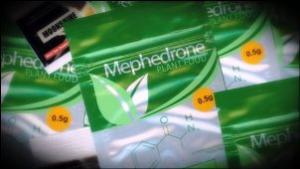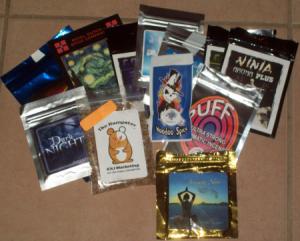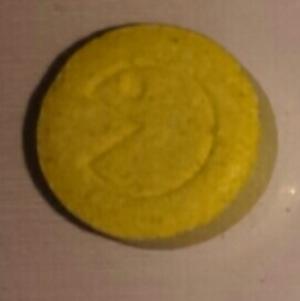by Phil Smith
This story was written in collaboration with AlterNet and first appeared here [19].
DRUG WAR CHRONICLE: In recent years, we’ve been inundated with wave after wave of media panics over strange new drugs. First came “fake weed” (or as NYPD Commissioner Bill Bratton called it last week, “weaponized marijuana”); then came “bath salts,” with the infamous face-eating episode that wasn’t [20]; and most recently, “flakka,” labeled as “$5 insanity [21]” by one media outlet.

These new (to the recreational drug market) substances mimic the effects of currently illegal drugs, such as marijuana, cocaine and amphetamines, or ecstasy. The states and Congress have rushed to address the drugs by prohibiting them, but that has proven to be a game of cat and mouse, with innovative chemists and manufacturers replacing banned drugs with new variants faster than politicians can act.
“In recent years, lawmakers have moved to ban wave after wave of NPSs, only to see more emerge,” said Grant Smith, deputy director of national affairs for the Drug Policy Alliance [22]. “All 50 states have passed laws against synthetic cannabinoids and cathinones, and federally, there are 26 unique compounds under Schedule I. And the DEA, which has legal authority to criminalize drugs administratively, has banned more than two dozen. These laws take time, which allows manufacturers to create new compounds.”
Not only is the prohibitionist reflex ineffective, it arguably increases the harms associated with the use of these drugs. But to ignore them or ban them aren’t the only policy choices, and some advocates are calling for these novel substances to instead be controlled and regulated. One model they point to is New Zealand, which instead of banning “legal highs,” moved to regulate them in 2013.
New Psychoactive Substances
Before turning to policy options, though, it’s worth a moment to figure out just exactly what we’re talking about when we talk about “new synthetic drugs,” and why maybe that isn’t the best term to use to describe these substances.
In a conference call organized by the Drug Policy Alliance, which advocates for regulation over prohibition, Earth and Fire Erowid, the administrators of the Erowid [23] drug information web site — “Documenting the complex relationship between humans and psychoactives” — tried to bring some rigor to a domain where science too often gets lost in the distortions of moral panic.
“Synthetic drugs is a term used to imply scary new street drugs,” said Earth Erowid. “But nearly all pharmaceutical drugs are synthetic, whether they’re cannabinoids, opioids, stimulants, or sedatives. You don’t want to use the phrase ‘synthetic drugs’ unless you’re talking about every pharmaceutical developed over the past 50 years.”
“A more accurate and appropriate term is “new psychoactive substances,” he said. “That’s the standard term in Europe.”
NPSs can be grouped into some general categories, based on the effects they seek to replicate, the Erowids said:

Replacement Cannabinoids. Sometimes sold as powders, sometimes sprinkled on herbal blends. These are not cannabis, but new synthetic cannabinoid receptor agonists. The specific compounds include JWH 018 and AB-PINACA, among many others. Several of these have been associated with death and serious medical complications.
Replacement Euphoric Stimulants. These include cathinones like methedrone, MDPV (“bath salts”), and Alpha PDP (“flakka”), as well as compounds related to Ritalin.
Replacement Psychedelics. The best known are the NBOMe series (“N-Bomb”). They are often distributed on blotters, and many people who think they’re buying LSD are getting this. The NBOMe class has been linked to about 20 deaths.
Replacement Dissociatives. These are PCP-like chemicals, including various ketamine variants and methoxetamine.
Replacement Opioids. These include chemicals such as AH 7921 and U4770.
The Drug Policy Alliance has a similar, if not quite identical, taxonomy here [24].
The deaths and other adverse reactions that have been linked to NPSs have occurred under regimes of either prohibition or its opposite — no regulation. “Legal highs” were just that, NPSs yet to be banned but lacking any sort of reliable labeling or quality control. Many formerly “legal highs” are now illegal, but the harm continues, and new NPSs continue to come on the market, legal until the politicians get to work.
“There’s a reason for that, said Earth Erowid. “People are looking for legal replacements for illegal drug effects,” he explained. “Most people simply want a stimulant or a psychedelic, and they’re willing to try anything if it’s legal.”
“That may hold true for “fake marijuana” users than other NPS users,” said Joseph Palamar, an assistant professor in the Department of Population Health at New York University’s Langone Medical Center.
“Synthetic marijuana users have different profiles from other NPS users,” he said “They are resorting to using it as a legal replacement for marijuana as a means of avoiding arrest, especially minorities. Other NPS users, especially clubbers and ravers, may be taking them unwittingly, Palamar added, pointing a finger especially at “Molly,” which is supposed to be pure MDMA in powder form, but often isn’t.
“Molly is the biggest system of unintentional NPS use that ever came around,” said Palamar. “A lot of the drug users, especially Molly users, are unknowingly taking NPSs.
(The Erowids helpfully pointed out that there are a number of web sites where users can submit their Molly for testing, including one they run at EcstasyData.org [25].)

There are other options for dealing with NPSs beyond the extremes of prohibition on the one hand and laissez-faire on the other. In some cases, it may be politically feasible to simply legalize the currently prohibited drug they are imitating.
Roger Goodman, chairman of the Washington state House Public Safety Committee and senior member of the Judiciary Committee, said that legalizing weed is a start.
“By legalizing marijuana, we have no problem with synthetic marijuana,” said Goodman. “No one wants to use that. We have a rational regulatory approach. Prohibition is in the past for us. Marijuana is a good first step for us. We know better than to impose prohibition and outlaw any particular substance.”
Legalizing marijuana more widely could put a real dent in the synthetic cannabinoids market, but there is no immediate prospect for legalizing drugs such as meth, cocaine, and the psychedelics and putting a dent in the market for other NPSs that way. That means if we’re not going to prohibit them and we’re not going to ignore them, we’re going to have to regulate them.
That’s what New Zealand did with its 2013 law, which transformed unregulated “legal highs” into regulated “legal highs” sold with labels at established stores. Drug makers were required to submit their products for testing and labeling before they could be approved for legal sale.
“I really look to the New Zealand law,” said Goodman. “It provided for licensing and testing, and it got rid of the criminal actors. It seemed like a very rational way to go.”
“That model would encourage manufacturers to make safer products,” DPA’s Smith concurred.
But, alas, the New Zealand law is no more. It was overturned and replaced [26] with a more prohibitionist retrenchment a year later amidst complaints that drug users were getting high and hanging around the dope shops like winos in front of liquor stores. That is a lesson for legalizers (or regulators) here. Not only are progressive drug reforms difficult to enact, they also sometimes require a strong defense.
This article is licensed under a modified Creative Commons Attribution license.

